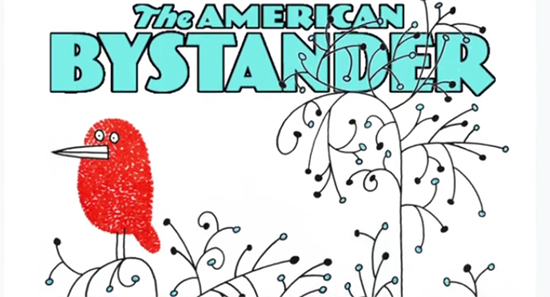There has been a lot of interest in the National Lampoon lately, from the documentary Drunk Stoned Brilliant Dead to Ellin Stein’s wonderfully comprehensive That’s Not Funny, That’s Sick, and the new movie A Futile and Stupid Gesture, which starts filming this month with Will Forte, Joel McHale, Domnhall Gleeson, and Martin Mull playing Lampoon regulars. It must seem strange to people to conceive of where all of that started – with a print humor magazine, the likes of which we haven’t seen in the US for decades.
Enter the American Bystander. Last year, this group, led by editor and publisher Michael Gerber, editor Brian McConnachie (who wrote for the Lampoon in the 70s), and co-founder Alan Goldberg, launched the print humor publication with essays, short pieces, and cartoons from contributors like Terry Jones (Monty Python) and Jack Handey (Saturday Night Live). They funded the first issue through Kickstarter, and now they are funding a second issue the same way, with another impressive list of contributors including Merrill Markoe (Late Night with David Letterman), Charles Barsotti (The New Yorker), and Zach Bornstein (Jimmy Kimmel Live).
They have already reached their goal of funding a second issue, which means new funding could go towards expanding the issue with more pieces, which is what happened in the Kickstarter campaign for the first issue.
I got in touch with Gerber to ask a few questions about the new issue and the new Kickstarter campaign.
What does American Bystander provide that’s missing from the print humor landscape, with all of the things people can get on the Internet?
Where is this “print humor landscape” you speak of? There’s MAD, and… what else? Lots of zines, for sure…The UK has some big humor magazines (Private Eye, VIZ, The Oldie), but America hasn’t for almost 20 years. McSweeney’s is beyond wonderful, but it’s not a humor magazine. The Onion print edition was great, but it’s gone now. Even at its glorious height, The Onion was a pretty narrow proposition, only one small slice of what National Lampoon offered, for example, in format and tone.
The Bystander is a relaunch of the classic print humor magazine format, adapted and improved for the post-internet age. We’ve got columns, short stories, poetry, prose parody, humor with graphic support, illustration, photography, one-panel cartoons, large cartoons, comics, and on and on. All in various voices, with various outlooks; most of it semi- or non-timely. If you look at print media from before 1990, you see a whole bunch of other formats that really don’t exist anymore, one because the literary culture that produced writers and artists that could create them, doesn’t exist anymore; and two because they can’t be consumed via phone and monetized via screen ads. Imagine reading Michael O’Donoghue’s “Vietnamese Baby Book” on your phone — you couldn’t. And what advertiser would be okay with having a banner on that piece? So that kind of work, to use just one example, doesn’t get made today.
We’re trying to preserve those formats, and re-introduce all these wonderful writers, so that the artforms of prose comedy and cartooning and comics stay vital — at least until e-paper or flexible tablets come along.
What’s the potential here? Are you assuming you’ll be up and running as a true quarterly after this campaign?
We already are. #1 was Winter ’15. #2 will appear in May. We’re already banking material for Summer ’16. If we can get the paying readers, we can produce the magazine. We need about 3,000 paying readers per issue; at 5,000 we can offer discounted subscriptions; and at 10,000 we’re virtually un-killable.
What was the letter from the eleven-year-old girl you mention in the video?
It wasn’t a “letter,” exactly; it was a picture sent to me on Facebook, accompanied by a message from her mother (an old high school friend), who said, “Sally [not her name] loved the issue, but was mad there weren’t more girls in it.” So I tried to make that a little more even this time — though it’s a constant fight. As in the improv comedy world, there seems to be an endless supply of young white men who want to crack jokes. Nothing wrong with that, I was a young white man myself once, but in general I think a diversity of experience can only reinforce the kind of splendid gallimaufry I mentioned in my answer above. It may always be a dream — the great humor magazines were appallingly monochromatic — and women and people of color with significant comic talent don’t usually pool in the backwater of literary humor. Something as poorly paid as print is a pursuit of the privileged or insane. But I will keep working on it, and I will keep working on ways to get writers and artists paid. That’s what attracts talent of all types.
What can people look forward to in the new issue?
Well, just today I got a marvelous piece from Simon Rich — he is such a wonderful writer. Merrill Markoe has some great pieces in — I love her voice; she’s even done a comic for us. I particularly like a piece that Steve Young (Letterman, Simpsons) has in #2. Yesterday, I laid out a lovely comic from Julia Wertz. Brian McConnachie and Jack Handey have this hilarious email chain about Dracula that we’re running. And Todd Hanson from The Onion wrote an amazing piece.
I could go on! Michael Ian Black is writing something now.
I think people will like Bystander a lot — they certainly enjoyed #1, which is still available via online bookstores and via special order at brick-and-mortar places. It’s really not anything like what other people are publishing — it’s really classic magazine humor. Not everybody’s cup of tea, but if you like that, you’ll love us.
